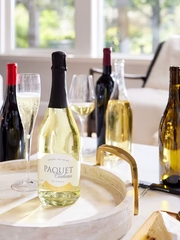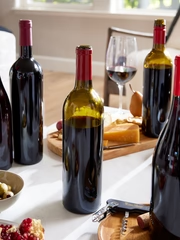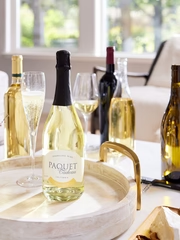Back in Ancient Rome, winemakers would burn candles made of sulfur in empty wine containers (called amphorae) to keep the wines from turning to vinegar. Winemakers began using sulfur in the winemaking process during the early 1900s to stop bacteria and other yeasts from growing (as opposed to just cleaning the wine barrels).
Sulfur dioxide or SO2 is also used everywhere in the food industry, as it is a proven way to protect perishable items for oxidation. The chart below, from
Wine Folly, shows the levels present in many of the types of food we consume every day.

Wine has fewer ingredients than a pot of Beef Bourguignon, cioppino, paella or gumbo. An ingredients label for wine might simply read: grape juice, yeast and sulfur dioxide. This last ingredient however is very complex and tricky to use.
Sulfur dioxide (SO2 for short) is by far the most important additive used in wine. Many times it is the only additive. Its value derives from its ability to perform several crucial functions. It preserves wine’s freshness and fruit characters by virtue of antioxidant, antimicrobial and anti-enzymatic properties. There is no other additive available to winemakers that can single-handedly play all of these roles. SO2 is required to make high-quality wines that can stand the test of time – and more importantly – your cellar.
 “Bound” SO2
“Bound” SO2
Anthocyanins are responsible for the color of red wine, while acetaldehyde gives wine a nutty, oxidized, sherry-like aroma. Yeast, bacteria and the chemical oxidation of ethanol produces acetaldehyde. When SO2 is added to wine, it reacts with acetaldehyde, greatly reducing its aromatic impact.
When SO2 has already reacted and becomes unavailable for any other functions, it is considered “bound.”
Free Sulfur or FSO2
SO2 that is present in wine but has not yet reacted is considered “free.” Free SO2 is what is still available to protect the wine. I am particularly attentive to the amount we use here at WineShop At Home, and this is the last addition that can be performed. As soon as the cork is on the bottle, that is it – no more magical tricks – it is up to the storage gods!
The term “total SO2” refers to the sum of both “free” and “bound” SO2. SO2 is typically added at various points in wine production: pre-fermentation, post-fermentation, ageing and bottling. Each of these stages has a different decision-making process for determining how much SO2 to add.
Pre-fermentation SO2 Addition
SO2 is traditionally added to crushed grapes or freshly-pressed juice to inhibit undesirable yeast and bacteria from producing undesirable compounds. Depending on the quality of grapes at harvest, 40 to 80 ppm (parts per million) of SO2 is added. High pH or warm grapes are susceptible to faster microorganism growth and also should receive a higher dose. Cold, clean fruit fresh from the vineyard can get by with a dose closer to the lower end of this range.
Post-fermentation SO2
This addition is also a critical step. If you measured the SO2 immediately after fermentation, you would find little to no free SO2 and a total SO2 less than half of your pre-fermentation addition. A standard addition at first racking of 80 ppm is usually required. Wines with a high pH (above 3.5) or late-harvest wines might call for 10-20 ppm more SO2. Sparkling wines, because of the protection of natural CO2, need less ppm.
Bottling SO2 Addition
This is usually the last critical step taken by the winemaker. My goal is to develop blends with just the right pH, acids, alcohols and sulfurs. Our Free SO2 content is usually around 25 mg/L at bottling time for the whites and 30 mg/L for the reds.
Limit Legal Reference/Descriptions:
USA 350 mg/L
AUS 250 mg/L
NZ 250 mg/L
EU white/rosé, 200 mg/L
EU red 150 mg/L
Producers in the United States have a much higher allowance for sulfites in wines. Our wines end up at 95% on the lower side – usually close to the legal limit imposed in Europe — around 150 mg/L.
Some of our bottling analysis:
Milano Dolcetto Free SO2, 23 ppm Total SO2, 82 ppm
Milano Misti Rosso Free SO2, 30 ppm Total SO2, 82 ppm
Milano Moscato Free SO2, 25 ppm Total SO2, 106 ppm
Cloud 9 Free SO2, 23 ppm Total SO2, 106 ppm
Cloud Symphony Free SO2, 31 ppm Total SO2, 121 ppm
Table Red Free SO2, 31 ppm Total SO2, 76 ppm
Sweeter wines usually get a little bump for extra protection.
 JEAN-MANUEL DUVIVIER
JEAN-MANUEL DUVIVIER
Most people can detect sulphur dioxide in water at around 11 mg/l. In wine, the presence of alcohol and acids means that it is less obvious.
Many people think that sulfites are the culprit behind wine headaches, but other chemicals are also involved. Some studies suggest that a naturally occurring substance in wine called tyramine may cause headaches, possibly due to the way it affects blood pressure. Wine, especially red wine, can also contain histamines, which some people can't metabolize.
Here at WineShop At Home, our goal is to protect the wines as well as the tasting experience for all our customers. We aim to deliver well-balanced wines that please the palate and the senses.
 Wine has fewer ingredients than a pot of Beef Bourguignon, cioppino, paella or gumbo. An ingredients label for wine might simply read: grape juice, yeast and sulfur dioxide. This last ingredient however is very complex and tricky to use.
Sulfur dioxide (SO2 for short) is by far the most important additive used in wine. Many times it is the only additive. Its value derives from its ability to perform several crucial functions. It preserves wine’s freshness and fruit characters by virtue of antioxidant, antimicrobial and anti-enzymatic properties. There is no other additive available to winemakers that can single-handedly play all of these roles. SO2 is required to make high-quality wines that can stand the test of time – and more importantly – your cellar.
Wine has fewer ingredients than a pot of Beef Bourguignon, cioppino, paella or gumbo. An ingredients label for wine might simply read: grape juice, yeast and sulfur dioxide. This last ingredient however is very complex and tricky to use.
Sulfur dioxide (SO2 for short) is by far the most important additive used in wine. Many times it is the only additive. Its value derives from its ability to perform several crucial functions. It preserves wine’s freshness and fruit characters by virtue of antioxidant, antimicrobial and anti-enzymatic properties. There is no other additive available to winemakers that can single-handedly play all of these roles. SO2 is required to make high-quality wines that can stand the test of time – and more importantly – your cellar.
 “Bound” SO2
Anthocyanins are responsible for the color of red wine, while acetaldehyde gives wine a nutty, oxidized, sherry-like aroma. Yeast, bacteria and the chemical oxidation of ethanol produces acetaldehyde. When SO2 is added to wine, it reacts with acetaldehyde, greatly reducing its aromatic impact.
When SO2 has already reacted and becomes unavailable for any other functions, it is considered “bound.”
Free Sulfur or FSO2
SO2 that is present in wine but has not yet reacted is considered “free.” Free SO2 is what is still available to protect the wine. I am particularly attentive to the amount we use here at WineShop At Home, and this is the last addition that can be performed. As soon as the cork is on the bottle, that is it – no more magical tricks – it is up to the storage gods!
The term “total SO2” refers to the sum of both “free” and “bound” SO2. SO2 is typically added at various points in wine production: pre-fermentation, post-fermentation, ageing and bottling. Each of these stages has a different decision-making process for determining how much SO2 to add.
Pre-fermentation SO2 Addition
SO2 is traditionally added to crushed grapes or freshly-pressed juice to inhibit undesirable yeast and bacteria from producing undesirable compounds. Depending on the quality of grapes at harvest, 40 to 80 ppm (parts per million) of SO2 is added. High pH or warm grapes are susceptible to faster microorganism growth and also should receive a higher dose. Cold, clean fruit fresh from the vineyard can get by with a dose closer to the lower end of this range.
Post-fermentation SO2
This addition is also a critical step. If you measured the SO2 immediately after fermentation, you would find little to no free SO2 and a total SO2 less than half of your pre-fermentation addition. A standard addition at first racking of 80 ppm is usually required. Wines with a high pH (above 3.5) or late-harvest wines might call for 10-20 ppm more SO2. Sparkling wines, because of the protection of natural CO2, need less ppm.
Bottling SO2 Addition
This is usually the last critical step taken by the winemaker. My goal is to develop blends with just the right pH, acids, alcohols and sulfurs. Our Free SO2 content is usually around 25 mg/L at bottling time for the whites and 30 mg/L for the reds.
Limit Legal Reference/Descriptions:
USA 350 mg/L
AUS 250 mg/L
NZ 250 mg/L
EU white/rosé, 200 mg/L
EU red 150 mg/L
Producers in the United States have a much higher allowance for sulfites in wines. Our wines end up at 95% on the lower side – usually close to the legal limit imposed in Europe — around 150 mg/L.
Some of our bottling analysis:
Milano Dolcetto Free SO2, 23 ppm Total SO2, 82 ppm
Milano Misti Rosso Free SO2, 30 ppm Total SO2, 82 ppm
Milano Moscato Free SO2, 25 ppm Total SO2, 106 ppm
Cloud 9 Free SO2, 23 ppm Total SO2, 106 ppm
Cloud Symphony Free SO2, 31 ppm Total SO2, 121 ppm
Table Red Free SO2, 31 ppm Total SO2, 76 ppm
Sweeter wines usually get a little bump for extra protection.
“Bound” SO2
Anthocyanins are responsible for the color of red wine, while acetaldehyde gives wine a nutty, oxidized, sherry-like aroma. Yeast, bacteria and the chemical oxidation of ethanol produces acetaldehyde. When SO2 is added to wine, it reacts with acetaldehyde, greatly reducing its aromatic impact.
When SO2 has already reacted and becomes unavailable for any other functions, it is considered “bound.”
Free Sulfur or FSO2
SO2 that is present in wine but has not yet reacted is considered “free.” Free SO2 is what is still available to protect the wine. I am particularly attentive to the amount we use here at WineShop At Home, and this is the last addition that can be performed. As soon as the cork is on the bottle, that is it – no more magical tricks – it is up to the storage gods!
The term “total SO2” refers to the sum of both “free” and “bound” SO2. SO2 is typically added at various points in wine production: pre-fermentation, post-fermentation, ageing and bottling. Each of these stages has a different decision-making process for determining how much SO2 to add.
Pre-fermentation SO2 Addition
SO2 is traditionally added to crushed grapes or freshly-pressed juice to inhibit undesirable yeast and bacteria from producing undesirable compounds. Depending on the quality of grapes at harvest, 40 to 80 ppm (parts per million) of SO2 is added. High pH or warm grapes are susceptible to faster microorganism growth and also should receive a higher dose. Cold, clean fruit fresh from the vineyard can get by with a dose closer to the lower end of this range.
Post-fermentation SO2
This addition is also a critical step. If you measured the SO2 immediately after fermentation, you would find little to no free SO2 and a total SO2 less than half of your pre-fermentation addition. A standard addition at first racking of 80 ppm is usually required. Wines with a high pH (above 3.5) or late-harvest wines might call for 10-20 ppm more SO2. Sparkling wines, because of the protection of natural CO2, need less ppm.
Bottling SO2 Addition
This is usually the last critical step taken by the winemaker. My goal is to develop blends with just the right pH, acids, alcohols and sulfurs. Our Free SO2 content is usually around 25 mg/L at bottling time for the whites and 30 mg/L for the reds.
Limit Legal Reference/Descriptions:
USA 350 mg/L
AUS 250 mg/L
NZ 250 mg/L
EU white/rosé, 200 mg/L
EU red 150 mg/L
Producers in the United States have a much higher allowance for sulfites in wines. Our wines end up at 95% on the lower side – usually close to the legal limit imposed in Europe — around 150 mg/L.
Some of our bottling analysis:
Milano Dolcetto Free SO2, 23 ppm Total SO2, 82 ppm
Milano Misti Rosso Free SO2, 30 ppm Total SO2, 82 ppm
Milano Moscato Free SO2, 25 ppm Total SO2, 106 ppm
Cloud 9 Free SO2, 23 ppm Total SO2, 106 ppm
Cloud Symphony Free SO2, 31 ppm Total SO2, 121 ppm
Table Red Free SO2, 31 ppm Total SO2, 76 ppm
Sweeter wines usually get a little bump for extra protection.
 JEAN-MANUEL DUVIVIER
Most people can detect sulphur dioxide in water at around 11 mg/l. In wine, the presence of alcohol and acids means that it is less obvious.
Many people think that sulfites are the culprit behind wine headaches, but other chemicals are also involved. Some studies suggest that a naturally occurring substance in wine called tyramine may cause headaches, possibly due to the way it affects blood pressure. Wine, especially red wine, can also contain histamines, which some people can't metabolize.
Here at WineShop At Home, our goal is to protect the wines as well as the tasting experience for all our customers. We aim to deliver well-balanced wines that please the palate and the senses.
JEAN-MANUEL DUVIVIER
Most people can detect sulphur dioxide in water at around 11 mg/l. In wine, the presence of alcohol and acids means that it is less obvious.
Many people think that sulfites are the culprit behind wine headaches, but other chemicals are also involved. Some studies suggest that a naturally occurring substance in wine called tyramine may cause headaches, possibly due to the way it affects blood pressure. Wine, especially red wine, can also contain histamines, which some people can't metabolize.
Here at WineShop At Home, our goal is to protect the wines as well as the tasting experience for all our customers. We aim to deliver well-balanced wines that please the palate and the senses.





